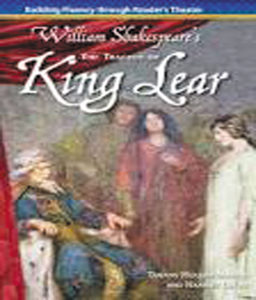 Pestilence was rife in the Bard’s time, closing theatres and ravaging life. Did Shakespeare write his bleak, desperate drama while self-isolating? We sift the evidence. . .
Pestilence was rife in the Bard’s time, closing theatres and ravaging life. Did Shakespeare write his bleak, desperate drama while self-isolating? We sift the evidence. . .
By Andrew Dickson, The Guardian
While those of us stuck in self-isolation or working from home watch TikTok videos and refresh liveblogs, a meme has been going around that claims Shakespeare made use of being quarantined during the plague to write King Lear. The Bard supposedly took advantage of the Globe’s lengthy closure to get on top of his writing in-tray – coming up with Macbeth and Antony and Cleopatra to boot. If you weren’t panicky enough about how little you’ve achieved recently, this is surely a way to feel worse. Why aren’t you finally dusting off that novel or screenplay you’ve been itching to write? It’s what the Bard would do, surely.
Yet, is it actually true, the bit about Shakespeare? Well, maybe. Certainly it’s fair to say that, like all Elizabethans, the playwright’s career was affected by the bubonic plague in ways that are all but impossible to conceive now, even in the midst of Covid-19. As an infant, he was lucky to survive the disease: Stratford-upon-Avon was ravaged by a huge outbreak in the summer of 1564, a few months after he was born, and up to a quarter of the town’s population died. Growing up, Shakespeare would have heard endless stories about this apocalyptic event and kneeled in church in solemn remembrance of townsfolk who were lost. His father, John, was closely involved in relief efforts and attended a meeting to help Stratford’s poorest. It was held outdoors because of the risk.
When Shakespeare became a professional actor, then a playwright and shareholder in a London company, plague presented both a professional and existential threat. Elizabethan doctors had no inkling that the disease was transmitted by rat fleas, and the moment an outbreak flared up – often during the spring or summer months, peak seasons for theatres – the authorities scrabbled to ban mass gatherings. Given that the authorities were naturally suspicious of theatre anyway, as being an incitement to lewdness and cross-dressing and God knows what else, playhouses were invariably the first to close. (Brothels and bear-baiting arenas, too, which some theatre owners relied on for income.) As a preacher of the time flatly put it: “The cause of plagues is sin, and the cause of sin is plays.” Between 1603 and 1613, when Shakespeare’s powers as a writer were at their height, the Globe and other London playhouses were shut for an astonishing total of 78 months – more than 60% of the time.
 These were dark periods for theatres in more senses than one. Actors were forced into other work and, of course, many died (people aged between 10 and their mid-30s were especially vulnerable). Companies broke up or were forced to tour in the provinces, hoping that news of the pestilence didn’t travel ahead of them. As at least one Shakespeare biographer has pointed out, there was a curious irony to the closures: Elizabethan theatregoers loved to snack on hazelnuts, which may have helped repel plague-carrying fleas.
These were dark periods for theatres in more senses than one. Actors were forced into other work and, of course, many died (people aged between 10 and their mid-30s were especially vulnerable). Companies broke up or were forced to tour in the provinces, hoping that news of the pestilence didn’t travel ahead of them. As at least one Shakespeare biographer has pointed out, there was a curious irony to the closures: Elizabethan theatregoers loved to snack on hazelnuts, which may have helped repel plague-carrying fleas. So how about the Lear theory? Not by any means impossible: we know the play was acted in front of King James I on Boxing Day 1606, the first performance on record, and it’s a decent bet that it was scripted that year or the year before. As the theatre historian James Shapiro points out, there was a major plague event in London in summer 1606, which led to the Globe and all other London theatres being closed. The outbreak wasn’t as bad as the one three years before that killed more than a 10th of London’s population, but it raged through the summer and early autumn, and the City of London parish where Shakespeare lived was one of those affected. Indeed, the playwright’s very house was touched: one of those who died that year was his landlady, Marie Mountjoy.
When you know this, it’s hard not to hear the echoes in Lear, arguably the bleakest tragedy Shakespeare wrote. The mood in the city must have been ghastly – deserted streets and closed shops, dogs running free, carers carrying three-foot staffs painted red so everyone else kept their distance, church bells tolling endlessly for funerals – and something similar seems to be happening in the bleached-out world of the play. The text is saturated by images of death, chaos, nihilism and desperation, and everyone seems to feel the chill. As Gloucester morosely observes: “Love cools, friendship falls off, brothers divide; in palaces, treason; and the bond cracked ’twixt son and father … we have seen the best of our time.” We don’t know for certain that Lear was a plague text – it’s nowhere near as explicit as Ben Jonson’s The Alchemist, or Thomas Dekker’s ironically entitled journalistic pamphlet The Wonderful Year, which relates the grisly events of 1603 – but it certainly feels like it.
It’s not the only Shakespeare play to make reference to plague or pestilence, an ever-present reality for the playwright and his contemporaries. Although there aren’t many direct references to bubonic plague in his scripts, it shadows the edge of the frame, more felt than seen. Occasionally it’s a plot device, as in Romeo and Juliet, where an outbreak catches the messenger sent by Friar Laurence and forces him into quarantine. This means the letter carrying news that Juliet has faked her death doesn’t reach Romeo. Earlier in the play, Mercutio’s line in Act Three: “A plague on both your houses!” might have raised a grim chuckle, even if it most likely referred to another deadly disease of the time, smallpox.
But in the plays written after that appalling outbreak of 1603, when even James I’s coronation had to be postponed, disease metaphors seem to infect Shakespeare’s work. The little-performed Timon of Athens culminates in a man sending himself into exile, where the word “plague” is barely off his lips: “Plagues … Your potent and infectious fevers heap / On Athens!” … “be crowned with plagues” … “send them back the plague / Could I but catch it for them”. Measure for Measure, which is as close as Shakespeare ever got to depicting the London of his own time, features brothels and bars abruptly shut down by an autocratic government, as they so often were in reality.
Macbeth, conceivably written during the 1606 epidemic, contains a short, knotty speech that would have struck fear into many spectators: “The dead man’s knell / Is there scarce asked for who, and good men’s lives / Expire before the flowers in their caps / Dying or ere they sicken.” As Shapiro notes: “Though less than four lines long, there’s probably not a better description of the terror and malaise plague carried with it.” And King Lear is even more brutally direct. Lear’s right-hand man, Kent, yells at the servant Oswald: “A plague upon your epileptic visage!” Lear describes the “plagues that hang in this pendulous air,” referencing the common theory that the disease could be spread by airborne transmission. And in one of his numerous rants, the King calls his daughter Goneril “a plague sore, an embossed carbuncle in my / Corrupted blood” – a nastily specific reference to enlarged lymph nodes, one of the symptoms of bubonic plague. Quite a thing to say to your daughter.
Whether the plague was a good thing for Shakespeare personally is more doubtful. For one thing, as a shareholder in two playhouses and a company, he will have been as anxious as any West End producer in 2020 about theatre closures, the effect on the bottom line, and whether there was even any point in him generating new scripts if no one could stage them. For another, we know he worked intimately with actors, his most trusted collaborators, and may even have written his plays in the theatre building; as a busy actor-writer-manager used to doing 17 things at once, isolation wasn’t his preferred mode, as far as we can tell. And it’s hardly as if plague times were restful, particularly if you were trapped in the city. Shakespeare’s house on Silver Street faced a church whose bells would have been constantly clanging for plague victims: no escape there.
It’s worth observing another point, too. During a previous terrible plague outbreak in June 1592, when the theatres were closed for nearly six months, Shakespeare turned to poetry: his long narrative poems Venus and Adonis and The Rape of Lucrece were both composed during this time, perhaps because their young author was desperate for a more reliable source of income. If the playhouses had stayed shut and his pandemic-forced career as a poet had taken off, there might have been no Lear – or Romeo and Juliet, Hamlet, Macbeth, Antony and Cleopatra, or any of Shakespeare’s best works.
• Andrew Dickson is the author of The Globe Guide to Shakespeare.















Follow Us